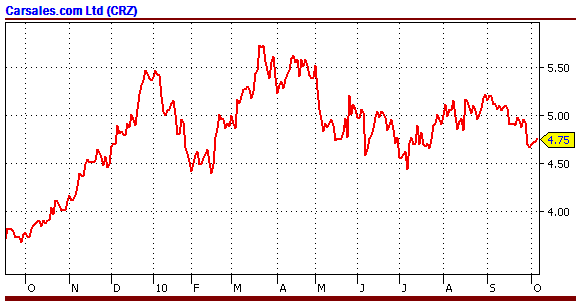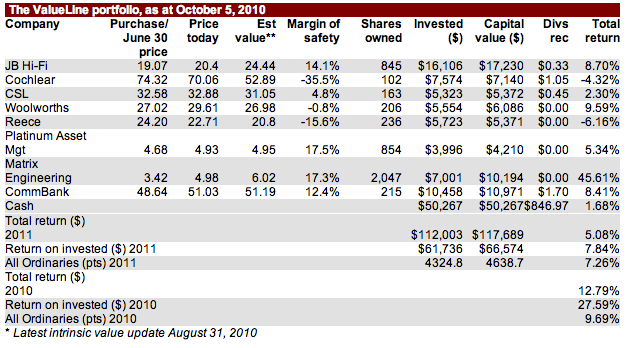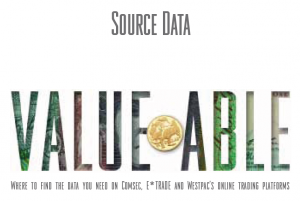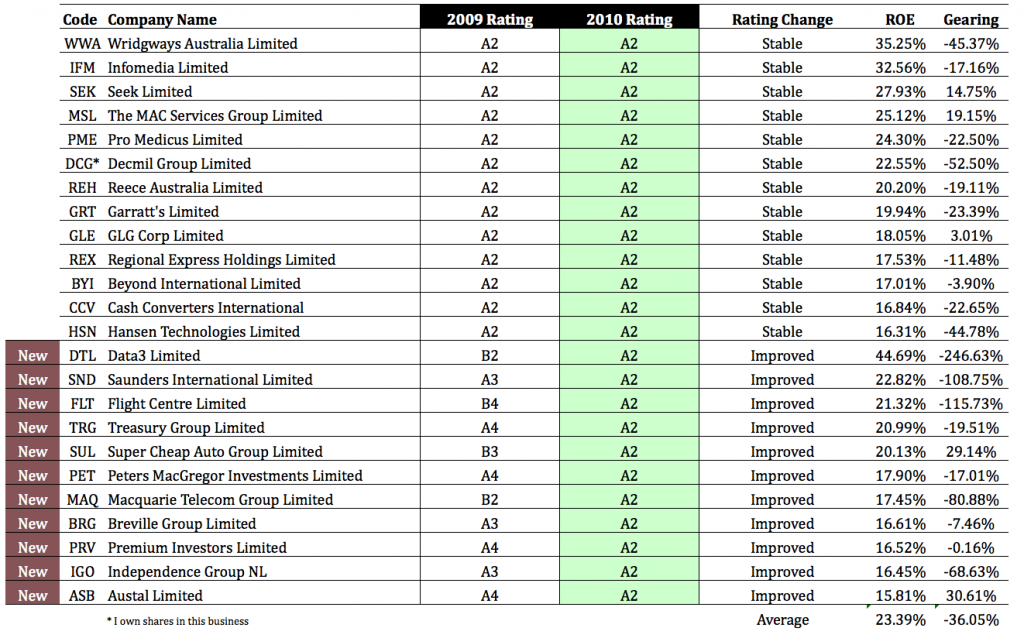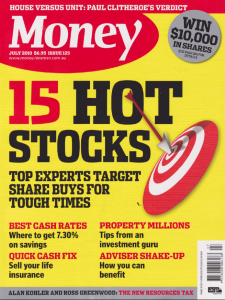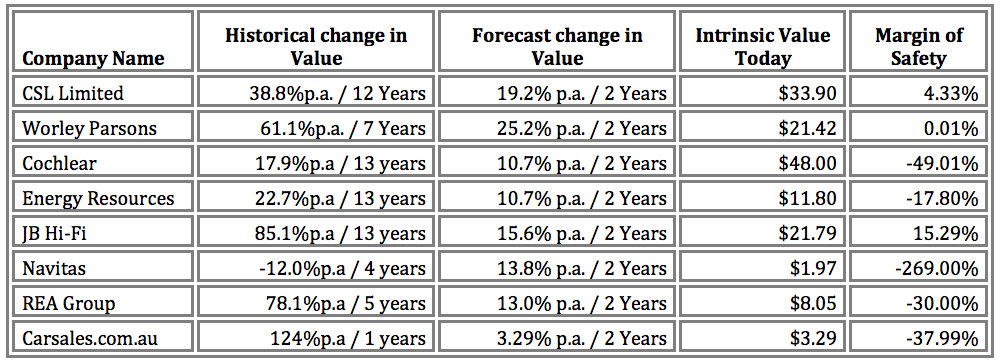Search Results for: thorn group
-
What are Roger Montgomery’s top 20 A1 stocks?
Roger Montgomery
November 15, 2010
Roger Montgomery describes his list of A1 businesses as a ‘wishlist’. Your goal as an investor is to find great businesses and buy them when their share prices are trading at big discounts to intrinsic value. Roger’s list of A1 businesses include fund manager Platinum Asset Management, manufacturer Cochlear, vitamin manufacturer Blackmores, online list Realestate.com.au, telecommunications business M2, mining services business Mineral Resources, IT services provider DWS, Centrebet, bull bar manufacturere ARB Corporation and one of Roger’s favourites, Oroton Group. Some of Roger’s A1s are cheap and some are expensive. One business is forecast to increase in intrinsic value by over 30% each year for the next three years and another by just 3%. User Roger’s list of A1s as a guide for your own ‘wishlist’, but ensure you always seek personal professional financial advice. Watch the interview.
by Roger Montgomery Posted in Media Room, TV Appearances.
- 7 Comments
- save this article
- 7
- POSTED IN Media Room, TV Appearances.
-
ValueLine: Westfield
Roger Montgomery
November 10, 2010
Westfield plans to spin off half of its Australian and New Zealand assets (about $12 billion) into a new vehicle called the Westfield Retail Trust (WRT). The company It also plans to raise $3.5 billion worth of equity to pay down debt associated with the original vehicle Westfield Group (WDC), which will own the remainder of the assets and stay listed. Roger Montgomery investigates if the de merger will restore the company to its glory days. Read Roger’s article at www.eurekareport.com.au.
by Roger Montgomery Posted in Media Room, On the Internet.
- 1 Comments
- save this article
- 1
- POSTED IN Media Room, On the Internet.
-
Have you been getting your daily dose?
Roger Montgomery
November 9, 2010
 If only it worked that well all the time!
If only it worked that well all the time!Last Thursday evening (4 November) on Peter’s Switzer TV I listed, amongst other companies, Credit Corp and Forge Group as two I would have in the hypothetical Self Managed Super Fund Peter challenged me to set up that day.
Why did I nominate CCP and FGE? Both receive my A1 or A2 MQR and both have been trading at a discount to their intrinsic value.
If you are a regular reader of my blog you would have read my insights for some months on these companies. And if you saw today’s announcements, you can imagine why I am a little happier than usual.
Credit Corp’s previous 2011 NPAT guidance was $16-$18 million. Today the company announced FY11 would likely produce an NPAT result of $18-$20 million.
Forge Group’s announcement states “The Board wishes to advise that the company forecasts net profit before tax for the half year ending 31st December 2010 to be in the range of $25-$27 million. This represents an improvement on the previous corresponding period (pcp $19.04m) of up to 42%.”
As I fly to Perth for a presentation and company visit, I am encouraged that several of the companies Value.able graduates mentioned in our lists are also hitting new 52-week highs. In a rising market that lifts all boats, it is perhaps unsurprising, but nevertheless it should be an encouragement to Value.able graduates and value investors that companies like FLT, DCG, MIN, FWD, FGE, CCP, NCK, DTL, MCE, MTU and TGA have all hit year highs – some of them yesterday. More importantly those prices are perhaps justified by their intrinsic values.
Of course I am not here to predict where those prices will go next, because I simply don’t know. Short-term prices are largely a function of popularity and the market could begin a QE2-inspired correction, an Indian infrastructure-inspired bubble or a China liquidity-inspired bubble tomorrow. I have no way of telling and instead, I focus on intrinsic values and only pay cursory attention to share prices.
So, as I always say, seek and take personal professional advice before taking any action and remember that 1) I don’t know where the share price is going 2) I am under no obligation to keep you up-to-date with my thoughts about these or any company, my Montgomery Quality Ratings or my valuations and I might change my views, values and MQRs at any time so don’t rely on them and 3) I may buy or sell shares in any company mentioned here at any time without informing you.
And so I remind you one more time. Please seek and take personal professional advice and always conduct your own research.
Posted by Roger Montgomery, 9 November 2011.
by Roger Montgomery Posted in Companies, Insightful Insights, Investing Education, Value.able.
-
Is one man’s trash another man’s treasure?
Roger Montgomery
October 25, 2010
 I am writing this post so that we have a record in the event Private Equity some day offers to offload the business to me. It’s one for those of you who have ever been to the local tip and paid for the privilege.
I am writing this post so that we have a record in the event Private Equity some day offers to offload the business to me. It’s one for those of you who have ever been to the local tip and paid for the privilege.It has been reported this week that Visy, the German-based waste group Remondis, Sydney-based Sita Environmental Solutions, private equity groups Ironbridge and Archer as well as listed disappointment Transpacific are all eyeing off garbage collector and tip owner WSN Environmental Solutions.
If you happen to live on Sydney’s north shore and ever had the delightful job of taking a trailer load of rubbish to the tip, you may be familiar with their North Ryde facility at Wicks Road. Drive onto the weigh bridge and over your credit card, go and dump your rubbish and unwanted items, get reweighed and both your car and your credit card are lighter. Ask the ladies at the entry which is the busiest day and they will gladly report; “every day, its always busy here”.
There are huge competitive advantages inherent in approved waste dump sites in high density areas. Environmental regulations ensure the approval of another site being built by a competitor next door is virtually impossible. WSN has 10 sites around Sydney and another at Moruya, about 250kms south of Sydney.
WSN collects kerbside waste, recylables and ‘clean-up day’ waste (225,000 households in 2009), and operates seven transfer stations that streamlines transporting and resource recovery. The company also operates an Alternative Waste Technology facilities as an alternative to landfill and its Eastern Creek facility processes 10% of Sydney’s household waste. The company operates materials recycling facilities (MRFs) at Chullora, Macarthur Resource Recovery Park (Narellan) and Moruya, sorting and recovering resources from the council kerbside collections of 450,000 households.
Aluminium, steel, plastic, paper and cardboard are sent (sold) to manufacturers to be processed into new products. Glass is processed at WSN’s new glass recycling plant at Chullora and marketed (sold) as an additive in bricks, tiles and water filtration materials.
At Lucas Heights, Eastern Creek, Ryde and Chullora Waste and Recycling Centres and Macarthur Resource Recovery park, WSN processes garden organics from 613,300 kerbside collections, as well as from drop-offs by householders (including me occasionally) and small businesses. These materials are used either as biofuel (sold) to produce green energy, or processed into compost and mulch products (sold) for agricultural and horticultural use.
The company also benefits from synergies with its subsidiary, Camden Soil Mix Pty Ltd, a leading composting and blending business in the Macarthur region that currently processes 10 per cent of garden organics in the Sydney basin market. Trading as Camden Soil Mix, the business continues to produce high quality compost from the kerbside garden organics that it receives from councils and contractors.
Think about that for a minute; Councils, individuals and businesses pay the company to take their rubbish away and the company is then paid to sell the processed output. It is paid by its customers and its suppliers. Only online lists and the big supermarkets can claim such wonderful economics.
Importantly, with landfill on the nose (pun intended), revenue from landfill now represents less than half of the company’s total. Back in 2003 it was 85%. Perhaps the biggest risks for the company under private ownership are regulations around environmental impact/footprint and the impact of transport and waste levy costs.
Revenues ‘excluding levy’ have increased substantially each year, despite the fact waste tonnes received was lower in 2009 than in 2005 and are generally stable. But for 2009, at least, that’s where the good news ended.
The business saw cash flow from operations drop by more than 50% from $42 million to $20 million and my ‘business cash flow’ calculation records a loss of $30 million. On a net basis however $44.5 million was spent on new property plant and equipment, but depreciation of roughly $20 million per year probably understates the actual maintenance capital expenditure. So call it a loss of $5 – 10 million. This was however a year (2009) in which expenses – particularly interest thanks to a near doubling of borrowings – significantly exceeded the previous year.
Like QR National, one expects private ownership would produce better results but the listed Transpacific Industries (ASX: TPI) achieves a C4 Montgomery Quality Rating (MQR) and is forecast to generate a return on equity of between 4-6% over the next three years (although TPI did raise $1 billion in 2007 and prior to that year generates much higher ROEs).
According to the media, WSN earned EBITDA of $30 million in 2010. Assuming debt hasn’t changed and is at $62 million (interest $5 million), Assets haven’t changed (depreciation & amortisation $22 million) and tax of 30%, the NPAT for 2010 was about $2 million, or a return on equity of about 1 per cent.
In theory there are some great assets with competitive advantages here (with the risk of legislative change always looming of course). I personally think it could be lucrative to own the Ryde transfer station with perhaps a green waste processing facility thrown in, but it seems the total is worth less than the parts. Perhaps that’s what Private Equity has noticed too.
Oh, and one other thing…watch out for the defined benefits plan, which according to the actuaries (read Buffett’s view about the way the fair values are arrived at) has a shortfall of $3.8 million – thankfully all closed to new members!
Published by Roger Montgomery, 25 October 2010.
UPDATE
A couple of weeks ago, Value.able Graduate Chris shared with me a story about his Grandad, a ‘scrapper’ in Adelaide.
There are some people in this world – affectionately known as “scrappers”, who do indeed take what is someone else’s trash and turn it into treasure. My Grandad was a ‘scrapper’ all his life because he used to recycle tins, lead, batteries, old cars – whatever he had – but he didn’t need to. He had his Army pension and his work pension, and him and Grandma lived quite comfortably, plus we also took care of them. I think that he just loved doing it – the game ! :) He loved the fact you could get something for nothing ! :)
Opal miners in Coober Pedy have been doing this kind of thing for ages – some of them are very, very rich and have a beautiful house down here in Adelaide, but have a rickety old shack up there, built out of scrap sheets and with DIY plumbing and wiring. I think that really, they like it that way – and you have to watch yourself when you set foot in their ‘house’ – never be critical of it or their hospitality, because you never know just who you might be talking to ! (and yes – I DO know some of these people as well, and the opal that they find is beautiful).
When you were in Adelaide, you’ll probably have noticed the “scrappers” riding bikes around or pushing trolleys. They’re raiding the bins for the 10c CDL refund – and let me tell you, I know a couple of them and they’re very savvy ! One of them has got a beautiful, MINT CONDITION 1986 Mercedes – in white. It is gorgeous. To most people, these guys look like they have nothing. Some don’t, but some are very, very wealthy from the sheer hard work and long hours of scrounging cans, iced coffee cartons and bottles to trade in for 10c a piece.
That’s why SA is such a great place – the home of the 10c refund. Yes – I do it too, but mainly for kicks and with whatever’s left over from daily life and the nightly one/two beers with dinner. I’m certainly not a “full time scrapper” like these people, but I put the money away and invest it on top of whatever I get from my normal job.
I love Gordon Elwood’s, Pokey Bills’ and Curt Degerman’s stories !
Chris
by Roger Montgomery Posted in Companies.
- 64 Comments
- save this article
- 64
- POSTED IN Companies.
-
Should I or shouldn’t I?
Roger Montgomery
October 12, 2010
 QR National is the second biggest float in Australia’s history and if I, as a value investor, am to be focused on extraordinary businesses, bought at discounts to intrinsic value, then the second biggest float ever deserves some of my attention.
QR National is the second biggest float in Australia’s history and if I, as a value investor, am to be focused on extraordinary businesses, bought at discounts to intrinsic value, then the second biggest float ever deserves some of my attention.But is QR National an extraordinary business? And is it available at a discount to its intrinsic value? They are the questions I need to answer.
QR Limited reported a loss of $37 million in 2010 (The Prospectus Appendix reports the continuing operations of QR Limited lost $37 million in 2010). A company-wide restructure, combined with customers rolling off old contracts and onto new, more commercial ones, as well as continued growth in coal haulage volumes however, is expected to result in a profit of $369 million in 2012 (and possibly much higher beyond that).
QR National will start its listed life with a balance sheet that has about $6.8 billion of equity. If QR National hits its targeted profits and pays its estimated dividends over the next 18 months, that equity will grow to $7.3 billion (I have excluded the impact on equity of the proposed dividend reinvestment plan). And if QR National hits its 2012 profit forecast, return on average equity will reach 5.1 per cent.
(POSTSCRIPT; Much is being made of the profits beyond 2012 and the return on the $3 billion invested. I had the opportunity to discuss this with L.Hockridge and he pointed to the prospectus forecast for an EBITDA run rate of $170-$190 million. Aside from the fat that EBITDA is nonsense the NPAT return on capital at maximum capacity will be about 6%. I talk about this below so I am not too worried about using the 2012 for a few years beyond it. In any event if 2015 and beyond is where the rewards are; why the rush to invest today?)
Given that I can invest in companies generating 40%, 50%, 60% even 80% returns on equity, should I consider a return that is less than that which cash in the bank generates?
Because the dividend yield is so miserly (and because of negative cash flow after capital expenditure, those dividends are effectively funded out of borrowings) the company is being pitched as a growth stock and growth story. Growth in coal volumes transported is the validation for the claim. But when a company generates a 5% return on the profits they keep, you don’t want it to grow. It is better they hand all the profits back to you so that you can put the money in the bank and get a higher and safer return. Of course they can’t hand the profits back to you because the cash flow won’t support it for reasons I explain next.
QR National is a capital intensive business and even before dividends are paid, the cash flow will be negative. Between 2008 and 2012 (5 years) QR National will have expended $7.2 billion on ‘capex’ and the company will need to borrow $1.5 billion in the next few years (the prespectus explains it will draw on over $2 billion). This will partially cover the gap between the capex and the cash form operations of $3.4 billion. The returns the company will be aiming for on this debt funding could be nine per cent or more, but my estimate is that the $170-$190 million in EBITDA from its GAPE project disclosed in the prospectus will be whittled down considerably by depreciation, interest and tax, such that the additional contribution to return on equity of the whole group may not be so significant.
As an aside the prospectus spends a great deal of time focusing on EBITDA (earnings before interest, tax, depreciation and amortisation) but as Charlie Munger once observed, whats the point of looking at “earnings before costs”? And as Buffett noted, the “tooth fairy” doesn’t pay for these things. Depreciation is a very real expense even though many finance professionals treat it as a non cash accounting item. In reality when depreciation is based on the historical cost of an item, it will under-provide for the true cost of maintaining and ultimately replacing that item. This is because the depreciation is based on the purchase price of the item many years ago, but maintaining and replacing it will suffer the impact of inflation. Thinking about it another way; imagine employing a thousand people for ten years but paying for them upfront and expensing the cost over ten years – would you then say the item is non cash and can be ignored? The real cost of employing these people will be higher than the depreciation suggests – they will demand salary increases. Looking at earnings before real costs is nonsense. Buffett’s advice from his 1989 letter to Berkshire Shareholders is even less accommodating: “Whenever an investment banker starts talking about EBDIT – or whenever someone creates a capital structure that does not allow all interest, both payable and accrued, to be comfortably met out of current cash flow net of ample capital expenditures – zip up your wallet.”
One other point: it appears to me that forecast profits (and by inference the 2012 Return on equity of circa 5%), may be boosted by some permitted accounting tricks. The future profits may be boosted by the capitalisation of interest on debt used to finance assets under construction. In other words not all of the interest expense in 2012 is flowing through the forecast profit and loss statement. Some of it will be capitalised (converted to an asset on the balance sheet). Telstra has done this with software development expenses and the end result is a profit figure that looks better than economic reality. For QR National it means that $369 million profit reflects accounting reality rather than economic reality.
I appreciate two things about this float. First, some of the smartest operators and management in the country are now driving it and as they point out, quite rightly, prospectus requirements limit their ability to discuss what happens beyond 2012 (but beyond 2012 anything can change, even management themselves). If however, it is the case that returns on equity will creep towards double digits after 2012, then I must ask myself if there is there any urgency to buy today?
The risk of course is the cost associated with paying a higher price for the shares at some future date when the wonderful performance is confirmed. The second thing I appreciate is that I cannot predict what the share price will do. The vendors and their advisors are pulling out every device designed to support the price of the shares after the float. There is the loyalty bonus that incentivises retail investors not to sell until December next year, and there’s the greenshoe permit that allows the managers of the float to step in and buy shares in the aftermarket. The share price may very well perform brilliantly. I am the first to admit that I am no good at predicting what the shares will do. That is the main reason why I always say you must seek and take personal professional advice. Your adviser is the only person who understands whether QR National or any company and their shares are suitable for you.
I estimate QR National’s shares have a 2012 intrinsic value of between $1.09 and $1.48, but thats in 18 months time. Given there will be 2.44 billion shares on issue, the intrinsic value of the whole business is about $3.7 billion in 2012. The intrinsic value is necessarily less than the equity or book value on the balance sheet because the equity is forecast to produce a lower return than that which I require from a business. The vendors want you today to pay up to double the 2012 intrinsic value ($2.40-$2.80 per share – loyalty bonus and Queensland resident bonus excluded).
I may indeed miss out on some gains if I don’t participate in the float, and I may miss out on very substantial gains. Of course there is the risk of loss too if I do participate. While I might be ok with either scenario, you may not be and so YOU MUST SEEK AND TAKE PERSONAL PROFESSIONAL ADVICE. My comments are general in nature and I have not taken into account anything about you or your financial needs and circumstances. If you want advice about what to do regarding the QR National float, speak to your advisor and if you haven’t got one, seek one out BEFORE doing or not doing anything.
Postscript: as one of my friends, Chris – also a fund manager – noted this morning: “I haven’t looked at the detail yet, but thought it was worth pointing out that the EV/EBITDA multiples they’re using might be a touch disingenuous. QR are using FY12 earnings on today’s balance sheet (i.e. current net debt of $500 million) despite the fact that they’ll have to drw down on at least $1.5 billion of further debt to generate those earnings. Essentially you might like to have someone check if they might be using today’s balance sheet and tomorrow’s earnings to lower the multiple.”
On a more navel gazing note…
Short-term price direction is not the trigger for a change of heart towards a company. Indeed, a falling price for an A1 business generally represents an opportunity. Sometimes however the nature of price changes has me sitting up and taking notice – being alert rather than alarmed.
Currently, JB Hi-Fi’s share price has been heading in the opposite direction to that of most of the A1 companies that I am following. Such determined selling has often been the precursor to an announcement. Let me make it clear that other than knowing JBH will hold its AGM tomorrow in Melbourne, I don’t know whether an announcement, for example a trading update, will be forthcoming or not. The rather unidirectional nature of the price changes however, often bodes poorly for the contents of any announcement. Keep a watchful eye therefore on JB Hi-Fi.
I found at my recent visits to a handful of JBH stores that they were busier than ever. But the recent share price changes suggests someone is nervous.
The only subsequent thought I have had is that the high Australian dollar has resulted in price deflation, which JB Hi-Fi’s competitors will take advantage of and the company will have to respond to by lowering prices, putting pressure on gross margins. JB Hi-Fi remains at a discount to my current estimates of intrinsic value and as I just mentioned, I generally take advantage of the market and its Wallet rather than listen to its Wisdom.
Keep an eye on JBH and any news from tomorrow’s AGM in Melbourne particularly about margins, deflation and the Aussie dollar at 11.30am.
Posted by Roger Montgomery, 12 October 2010.
Postscript #2: JBH AGM notes. first quarter trading has improved. Total store sales are up 12.2% but behind BUDGET (not last year comprables) by 5%. JBH expects to make it up over CHristmas but evidently they didn’t mention the previous guidance of 17% growth in sales (perhaps this IS budget). Store roll out is on track and 18 additional stores are expected to be opened in the current financial year. They DID say that they are well placed to maintain margins despite discounting. Newspapers this morning point to a raft of new games to be released (JBH is the second biggest retailer of computer games) for Christmas.
by Roger Montgomery Posted in Companies, Energy / Resources.
- 170 Comments
- save this article
- 170
- POSTED IN Companies, Energy / Resources.
-
Carsales.com.au is an A1 business, but is it cheap?
Roger Montgomery
October 7, 2010
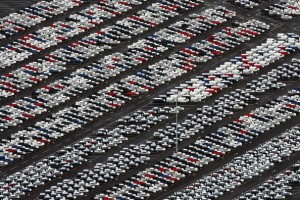 Each Wednesday I write my ValueLine column for Alan Kohler’s Eureka Report. Usually I post a link to my article the following day here at the blog. This week Alan has generously allowed me to republish my insights. Visit the Eureka Report website, www.eurekareport.com for more details about Alan’s newsletter.
Each Wednesday I write my ValueLine column for Alan Kohler’s Eureka Report. Usually I post a link to my article the following day here at the blog. This week Alan has generously allowed me to republish my insights. Visit the Eureka Report website, www.eurekareport.com for more details about Alan’s newsletter.ValueLine: Carsales.com
Ever noticed that the biggest and best online businesses are lists? Lists of websites, lists of houses, lists of flights, lists of jobs, lists of hotel rooms … even lists of people!
The business of curating and providing lists can be an extremely lucrative one because there is no need for a warehouse or a manufacturing plant. Nor is there a need for inventory and there is potentially very little maintenance spending required.
But because anyone with access to a server and knowledge of a programming language can imitate the business model, what is needed to be successful is a sustainable competitive advantage. More about that in a moment.
Last year nearly one million cars were sold in Australia; this year the figure is expected to be even higher. Of Australia’s adult population of 19.3 million, 5.3% buy a new car every year. Excluding January sales (when everyone is on holidays) and June sales (with end of financial year run-outs) about 85,000 new cars are sold each month.
That’s a lot of new cars being bought, and one suspects that just as many second hand-cars being sold too. One company leveraged to this industry without having to buy stock, lease a showroom or pay the wages of mechanics is Carsales.com (CRZ).
After a decade of business under private ownership, Carsales.com was floated at $3.50 a share in September 2009 in one of the most highly anticipated listings of the year. As is often the case with such floats, very few retail investors were able to get an allocation.
Today Carsales (CRZ) is Australia’s largest online list of cars, with about 205,000 units available for sale as of June this year.
For the year to June 2010, Carsales reported a profit of $43.2 million, which was $16.8 million less than listed car dealership Automotive Holdings (AHE). Automotive Holdings reported a profit of $60 million but required $1 billion of assets and $376 million of equity to produce it.
By way of comparison, Carsales required just $114 million of assets and $89 million of equity. Automotive Holdings generated a return on assets of 6.5%; Carsales’ figure was 39%.
If they were your assets, which return would you prefer?
For every dollar of sales, Automotive Holdings generates earnings before interest, tax, depreciation and amortisation (EBITDA) of 3.8¢. Carsales generates EBITDA of 52¢ from every dollar of sales.
If you could own one of these businesses, which would you prefer?
Carsales dominates Australia’s online lists of cars, capturing roughly half the market. Its next nearest competitor is the Newscorp-owned Carsguide with 93,000 cars for sale at mid-August, followed by the Trading Post with 69,000 cars.
For the full year to June 2010, Carsales’ revenues increased by 28%, with operating costs rising by less than 12% and net profits increasing by over 41%.
One of the keys to sustaining this kind of performance is a competitive advantage and while many conventional reports cite brands and systems as sources of competitive advantage, Carsales’s advantage comes from what is known as the network effect.
This is arguably one of the strongest sources of competitive advantage and it is evident when the value of a service increases for both new and current users as more people begin to use that good or service.
Think about it like this.
As more people list their cars/jobs/properties on a website, more people visit that website because it has the more cars listed. As more people visit the website, it justifies more people listing their cars there and this virtuous circle continues to work in favour of the dominant site, until an unbridgeable moat exists between Carsales.com and the other brands.
In an effort to break the cycle, one of Carsales’ competitors offered vendors the opportunity to list their cars for free but even that failed to put a dent the growth trajectory of Australia’s leading car classifieds website.
Carsales enjoys the same benefits of the network effect as Seek (SEK) does in job ads, REA Group (REA) does in real estate and Wotif (WTF) does in accommodation. This network effect is as visible and obvious as it is entrenched for Carsales.com and investors looking to buy a wonderful business would be hard-pressed to find many more attractive (for more of Roger’s thoughts on web-based businesses, click here).
Now the reality is that Carsales’ largest shareholder, PBL Media, owns 49% of the company and at some point that stake will be sold. But investors fearing the overhang should be less concerned by who buys and sells the shares and more concerned with whether the intrinsic value of the company is rising or not.
Carsales’ intrinsic value is rising. My forecasts suggest intrinsic value will rise 19% for each of the next three years and, let me assure you, there are few companies that can even promise that.
But a rising intrinsic value is just one of the characteristics the ValueLine portfolio seeks. The other is a discount to today’s intrinsic value. And that is the only test that Carsales.com. does not pass.
Carsales.com is an A1 business with a strong competitive advantage that is generating excellent returns on assets but, according to my calculations, its intrinsic value is $3.77. If we compare this to yesterday’s closing price of $4.72, it is approximately 25% overvalued.
In 2012, my estimated intrinsic value for Carsales rises to $4.65 and in 2012 to $5.24, but disciplined value investors need to make sure that everything lines up perfectly to pursue a successful investment strategy.
Carsales is not currently trading at a discount but it is a great business to keep in mind, should the market temporarily change its mind.
Posted by Roger Montgomery, 7 October 2010
by Roger Montgomery Posted in Companies, Value.able.
- 48 Comments
- save this article
- 48
- POSTED IN Companies, Value.able.
-
How do Value.able graduates calculate forecast valuations?
Roger Montgomery
October 1, 2010
 I know of no other book in the world that discusses the concept of calculating future intrinsic values. You may think that is a bold statement, but its true. I have seen many books that claim to reveal Warren Buffett’s intrinsic value formula, but not one that lays out, step-by-step, what investors need to look at to determine whether intrinsic value is rising at a satisfactory rate in the future.
I know of no other book in the world that discusses the concept of calculating future intrinsic values. You may think that is a bold statement, but its true. I have seen many books that claim to reveal Warren Buffett’s intrinsic value formula, but not one that lays out, step-by-step, what investors need to look at to determine whether intrinsic value is rising at a satisfactory rate in the future.I confess to chuckling recently when one investor told me that they were finding it a little difficult to source the data they needed to calculate future intrinsic values. They also believed that my book lacked an explanation for how to calculate future intrinsic values.
So I asked whether or not they had even thought about future intrinsic values before having read Value.able? Sheepishly, the investor accepted that my book was much more valuable than they had initially concluded and subsequently told other people.
I have not found any other book in the world that has taken that little Buffett quote about finding businesses growing intrinsic value at a “satisfactory rate” and making it part of a clearly explained and defined investing process.
And for those of you who are looking for a reference to forecast equity per share in Value.able…. see Page 188, Step A.
The missing worked example for future equity. It’s easy!
How can you estimate future equity if you don’t have a forecast number such as those readily available in analyst research notes? It’s easy. Take the last known equity per share figure, add the estimated profits, subtract the estimated dividends, add any capital raised through new shares issued and subtract any equity paid back to shareholders through buybacks and you have it.
Here’s an example: In the 2010 annual report for The Reject Shop, equity at 30 June 2010 was $51.543 million (click here to see) and there were 26.034 million shares on issue. Dividing the 2010 ending equity by the shares on issue ($51.543/26.034) equals equity of $1.98 on a per share basis.
According to Commsec (click here to see), consensus analyst estimates for 2011 earnings per share and dividends per share are $1.028 and $0.744 respectively.
Starting with the 2010 equity per share of $1.98, add the earnings per share of $1.028 and subtract the dividends per share of $0.744 to arrive at an estimated ending equity for 2011 of $2.26. (If you are aware of any shares issued since the end of the financial year, you may want to take the amount raised and divide it by the number of shares issued and then add that result to the $2.26)
Now that you have seen it done, how easy is that?
A global movement begins!
I couldn’t be happier that a small group of passionate Australian value investors are even contemplating future intrinsic values! Nobody in the world is presenting you with estimates for intrinsic values, two, three or four years out and I have never seen any investor ever do it. I know of nobody else in Australia doing that, nobody has written about it before and I haven’t ever come across anyone else in the international business media discussing it either.
And now you are all doing it! It has become part of your vocabulary.
Think about that for a minute… after reading Value.able, investors are now estimating future intrinsic values, posting their estimates at my blog and Facebook page,and chatting about them online in forums and in boardrooms where previously nobody was.
If before reading Value.able you weren’t discussing future intrinsic values and now you are, then my book has had a positive impact and I am delighted. And all for just $49.95!
Consider how you are now subconsciously framing your investing decisions with future intrinsic values in mind.
Warning!
Don’t blindly combine numbers with Value.able’s valuation tables to produce intrinsic values. As I say in my book, you MUST understand the business and its prospects. I devoted an entire chapter to cash flow and its calculations. Don’t ignore it. I also devoted an entire chapter to competitive advantages. Don’t ignore that either.
Recently, Buffett sold down his holding in Moody’s because it had lost some of its competitive advantage. He isn’t selling because he has recalculated intrinsic value. It’s the competitive advantage that drives the intrinsic value.
Be careful you aren’t so focused on the intrinsic value number that you ignore all the other important factors.
Its one of the reasons I have my Montgomery Quality Ratings (MQRs). They are my own filter to help narrow the universe of companies to conduct further research on.
I put a lot of effort into writing my book and making an investment plan out of the best of what the world’s most successful investors have revealed, published and taught. And I am delighted that you have allowed me to share that with you. Thank you.
Where do I get the raw data Roger?
I have previously posted a document called ‘Source Data’, where Value.able graduates contributed their solutions to obtaining the data. Because I am receiving so many requests for help finding the data, I thought it useful to republish it. Click here or click the Value.able Source Data button to the right.
I was saddened to hear that one Value.able reader thought getting the data was all too hard and gave up. That’s like knowing there’s silver and gold a metre under your feet but saying that grabbing a shovel and digging is just too hard. If you don’t want to do the work that’s fine, but please don’t blame the guy who gave you the map, the pick and the shovel.
Using the information in my Source Data document, you should now be in a rock solid position to start estimating future intrinsic Value.able values.
Take a look at the Source Data document and you will see that the raw data is freely available. Indeed every single number you need to estimate the current intrinsic value is also available in a company’s annual report, and its all free at ASX.com.au.
With sources like Commsec and the formula I have given you for future equity, you can now freely estimate the forecast intrinsic value as well. Just go to ASX.com.au, click on the announcements link, select the company code and the year you need and voila! All the information is there in the annual report.
Value.able outlines the way I invest. I don’t have a green button that I press each day that automatically goes and buys the best opportunities. Value investing requires research and analysis. We can build devices that give us some short cuts, but they don’t replace the need to understand the business and the risks.
Why are my valuations different to Roger’s?
If everyone uses exactly the same inputs, our Value.able valuations will all be identical. Any differences therefore are due to different data. Some examples of sources of variation are:
- Online brokers’ ROE numbers are calculated differently to the way I suggest in Value.able. They use ending equity and I suggest average equity.
- Generic net profit after tax figures available on various online summary lists may or may not remove abnormal/significant or non-recurring items. Intrinsic values should be based on recurring profits, revenues and expenses. (Yes there is some subjectivity in this).
- I have noticed many of you using 10% discount rates for all companies. As I suggest in Value.able, this may be too low in some cases.
There are a variety of reasons and your Value.able valuations are different to mine.
Recently on TV I indicated that my valuation of Telstra was closer to $2.30-$2.50, but one Value.able graduate produced $3.68. I suspect that the difference is simply the choice of discount rate. Many investors will use a low discount rate because TLS such a big company with plenty of liquidity and very low risk of significant change. I however might use a higher rate because I want compensation for the fact that its future prospects are opaque and its profits haven’t grown a dollar in a decade.
Thinking about differing results, I am encouraged that many Value.able graduates were able to replicate my results exactly, or within a couple of cents.
Value.able will stand the test of time because it is based on a method of investing that works. It is a method of investing that requires time to demonstrate its value. And in time I look forward to hearing many more of your success stories.
Only a few First Edition hardback copies of Value.able remain. So if you haven’t purchased your reserved copy yet, now is not the time to ponder.
There was only one print run of the First Edition hardback. The paperback Second Edition will be available in mid November.
Posted by Roger Montgomery, 1 October 2010.
by Roger Montgomery Posted in Companies, Insightful Insights, Investing Education, Value.able.
-
Essential elements
Roger Montgomery
September 27, 2010
Author and stock analyst Roger Montgomery thinks more value is emerging among Australian stocks. Forge Group, JB Hi-Fi, ARB Corporation, Woolworths and Wotif.com are among the value investor’s preferred stocks. In his new book, Value.able, Montgomery argues against being guided by the price-to-earnings or price-to-book ratio and instead focuses on return on equity.
by Roger Montgomery Posted in In the Press, Media Room.
- READ
- save this article
- POSTED IN In the Press, Media Room.
-
Part IV: Where should you focus your digging?
Roger Montgomery
September 15, 2010
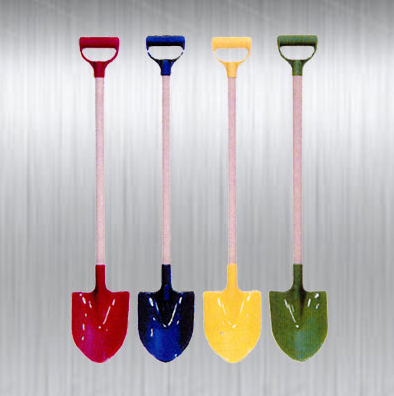 While everyone else seems to have moved on from reporting season, I’m still digging my way through a mountain of analysis. I am almost done.
While everyone else seems to have moved on from reporting season, I’m still digging my way through a mountain of analysis. I am almost done.Based on the amount of comments contributed here at my blog it seems you have enjoyed reading my insights as much as I have enjoyed sharing them.
Before I get into what I have uncovered from last week’s filings, congratulations are in order. Gavin was the first Value.able Graduate to correctly pick the three companies I omitted from Part III’s second table – congratulations Gavin. Gavin picked all three despite there being thousands of companies listed on the ASX and only having six pieces of financial data. Amazing!
Congratulations are also in order to Mike and Pat, who picked all three. Great digging fellow Value.able Graduates!
The missing companies are ARB Corporation (ARP), Wotif.com (WTF) and Mineral Resources (MIN).
As always, please undertake your own research and seek and take personal professional advice before you go rush out and buy anything.
I also wanted to say a big thank you to all who have posted comments. Our Value.able investing community has benefited greatly from your contributions and insights and I am excited by the great sense of community that you have developed. I must say a special thank you to our regular contributors – the quality of your comments are amazing, and more importantly, respectful and non-judgmental. Keep them coming!
If you haven’t yet posted a comment, now is a great time to start. The Value.able community is here to share ideas and help each other. If something is on your mind, I guarantee there is someone else with a similar question. So please contribute as much as you can or ask as many questions that you may have.
Now onto my lists – despite all my digging, there is only one new entrant into my A1 Montgomery Quality Rating this week. With three companies experiencing rating declines, on a net basis we actually lost two A1s. You can see them below.
Dominion Mining (DOM) had the largest rating decline, from an A1 to an A3. It still displays high quality metrics – with $16m in cash on the balance sheet and no debt (just watch out for those capitalised exploration expenditures), but my Montgomery Quality Rating declined. Why?
As you know, I tend to shy away from commodity businesses. It is not that they are difficult to understand, but rather difficult to forecast with a great deal of confidence – forecasting how much they will produce and when, their cost of production and/or project establishment and development costs and then ultimately, what price they will get for their production. There are simply too many variables that management can get wrong and many that are completely out of their control.
To this point I proffer Dominion (ASX: DOM), which in the most recent financial year, despite a higher average gold price, saw production slip from 98,755 ounces to 80,570 and cash production costs blow out from $438 to $697 per ounce. The combination of lower production and lower efficiencies transformed a highly profitable business into a barely profitable one in the space of 12 months. Now that’s operating leverage!
Indeed if you took all of the hitherto-labelled ‘resource evaluation and mine development expenditure’ expenses straight to the Profit and Loss account as opposed to the Balance Sheet, DOM would have made a loss of several million.
Given the many variables and accounting flexibility, if exposure to this sector is your goal, perhaps your focus could move from those who ‘look for’ and ‘produce’ to those who ‘service’ – the suppliers of the picks and shovels and those engineering businesses that install, maintain and replace all the picks and shovels. In my opinion, there are fewer variables and the economics haven’t changed since the days in 1851 when a gold rush in Ballarat saw 10,000,000 grams of gold delivered to Melbourne’s Treasury.
Back to my A1’s… the only entrant this week is Centrebet International (CIL). Remember that this is in addition to the 30 revealed so far in my previous posts – Part I, Part II and Part III. My A1’s now total 31.
CIL is in the business of online wagering and gaming and appears to have carved out a niche in Australia’s multi-billion dollar gambling market.
Take a look below and you will also see those companies that have achieved an A2 Montgomery Quality Rating since my previous blog post. The average ROE of this group is an impressive 23.39% (albeit around half that of my A1’s) with an average gearing level of -36.05%. There are plenty of Balance Sheets here reflecting a net cash position.
Combine my A1s and A2s (78 in total) published in the past couple of weeks and you have an excellent starting point from which to begin your own digging (by doing your own research and seeking independent personal and professional advice).
I will also mention that I may own any of the above companies and that I may buy or sell at any time – even tomorrow, and I am under no obligation to keep the list up to date in any way, shape or form. Before you do anything, YOU MUST conduct your own research and I insist you obtain independent personal and professional advice considering your needs and circumstances.
Value.able gives you the simple steps to follow to estimate a value for each company yourself and some thoughts to consider in regards to qualitative factors, such as competitive advantage. If you are not already a Value.able Graduate, why not?
Also remember that the share price may halve tomorrow. DO NOT buy shares in any company simply because I like it or own it – that is not investing, that is speculation. Speculating that I am right is not investing. That is the exact opposite of the value investing doctrine I espouse.
Reporting season will soon be a distant memory and the media, analysts and ‘investors’ will start to think about other things… the economies of the US, China and Europe will start to tickle the minds of idle analysts and commentators, but your focus should remain on great quality companies trading at very big discounts to intrinsic value.
Posted by Roger Montgomery, 15 September 2010.
by Roger Montgomery Posted in Companies, Insightful Insights, Investing Education.
-
Which recently listed mining services business is a Roger Montgomery A1?
Roger Montgomery
August 26, 2010
In this appearance on Market Moves Roger Montgomery tells stock market investors that BHP is a superior business to RIO, AGL is an average business and expensive, and the intrinsic values of both Worley Parsons (WOR) and Flexigroup (FXL) are rising over the next few years. But it is a recently listed mining services business that has money on its books, little or no debt and rising ROE that Roger is really excited about. Watch this interview to discover Roger Montgomery’s most recent A1 find. Watch the interview.
by Roger Montgomery Posted in Media Room, TV Appearances.
- save this article
- POSTED IN Media Room, TV Appearances.
-
Part II: What else has the reporting season avalanche uncovered?
Roger Montgomery
August 24, 2010
 The second full week of reporting season has just been and gone and saw another 80-100 companies report their financial results. More than 200 have reported and yes I am working feverishly to keep up and cover them all. I am happy to report that I’m ready for another week.
The second full week of reporting season has just been and gone and saw another 80-100 companies report their financial results. More than 200 have reported and yes I am working feverishly to keep up and cover them all. I am happy to report that I’m ready for another week.So far the results have been mixed. Information Technology, Banking and Mining/Oil & Gas Services sectors have stood-out, receiving high Montgomery Quality Ratings. The remainder have been distributed somewhat randomly amongst the other sectors.
And having analysed all of them so far, I can reveal that only 11 (5.5%) of the 200 have achieved my coveted A1 status (an additional six on top of the five from my previous post). These businesses have all passed my rigorous stress tests and come up trumps.
You may be surprised that after another full week and 80-100 individual results, only six additional companies have made it. But my A1 rating system has been specifically formulated to yield only the best and it is performing its function very well.
Of the six companies, three held onto their A1 status. These are Carsales.com.au (CRZ), Forge Group (FGE) and Monadelphous (MND) which have been joined by 3 new entrants in DWS Advanced Business Solutions (DWS), Finbar Group Limited (FRI) and SMS Management and technology (SMX).
Unfortunately, on a net basis we lost one A1 this year with four other businesses experiencing ratings declines from A1. These businesses include CSL limited (CSL), Consolidated Media Holdings (CMJ), Integrated Research (IRI) and McMillan Shakespeare (MMS). While CSL and CMJ have both declined to A2 status – nothing to be sneezed at, IRI and MMS have had larger rating declines.
Most notably, MMS has declined materially in terms of quality as I predicted it might after its acquisition, and it is now a ‘B3’. The mostly debt-funded acquisition of Interleasing (Australia) is the cause of this fall which I will cover in a separate post.
There are also another 20 A2 businesses that have passed my stress tests and rate in the top 15 per cent of the market in terms of overall quality.
Don’t forget to combine these lists with the A1 and A2 businesses I highlighted last week to continue identifying the best of the rest and stay tuned, I will post my intrinsic valuations for all 11 A1 businesses soon.
Finally, an update on my Telstra valuation. Last week I said that my valuation following the annual result was $2.50. I have updated my numbers and now get $2.30.
I sincerely hope that my Telstra comments have served your research well and that you have not been caught by all of the “it’s high yield and therefore a cheap stock” talk.
While others may have been tempted to buy shares for ‘yield’, you can use Value.able to first discover the intrinsic value. To save you a little time, Telstra’s valuation has declined since it listed. Even in the past year intrinsic value has fallen from $3.00 to $2.30! And the share price has fallen from $3.55 to the current $2.77.
In reality this is a widely reported and closely tracked company and its weighting in the index ensures a level of support from the large, conventional, index-based and tracking-error-focused funds. Indeed this is one of the reasons it has taken so long for Benjamin Graham’s weighing machine to catch up to the valuation – ten years! An improvement in the clarity for Telstra (forgetting whether its profitable for the business) could be enough to result in substantial price rises. Of course as a disciplined value investor focused on only the highest quality business, I cannot let that speculation tempt me.
Posted by Roger Montgomery, 24 August 2010.
by Roger Montgomery Posted in Companies, Investing Education, Value.able.
- 103 Comments
- save this article
- 103
- POSTED IN Companies, Investing Education, Value.able.
-
ValueLine: Montgomery’s new favourite stock(s)
Roger Montgomery
August 18, 2010
Finding an undervalued stock is a wonderful thing. Finding a group of them is something else. In this edition Roger identifies a cluster of undervalued companies and adds one to his benchmark-beating portfolio. Read article.
by Roger Montgomery Posted in Media Room, On the Internet.
- 8 Comments
- save this article
- 8
- POSTED IN Media Room, On the Internet.
-
What are investors saying about Value.able?
Roger Montgomery
August 3, 2010
 It has been four days now since the very first copies of Value.able were received.
It has been four days now since the very first copies of Value.able were received.I am very grateful for your feedback and I am impressed. I have received some requests to check valuation workings and many of the valuations I have seen so far are close enough to ‘spot on’. Congratulations everyone. It looks like the penny is dropping all over Australia as well as in Asia, Canada, the UK and the US.
Rather than continuing to check your workings individually, I thought I would post some calculations in the next few days for you to check your own workings against. A ready reckoner if you will.
There will be ten Value.able valuations for widely-held and well-known companies that you may use to cross-check against your own calculations. I will include the inputs used, so that we are comparing like with like. These valuation examples will be available by the end of the week. They are ASX Ltd, Computershare, Caltex, David Jones, Foster’s Group, Leighton, McMillan Shakespeare, Westpac, Woolworths and Wridgways.
Until then, I wanted to take this opportunity to express my sincere thanks for the overwhelmingly kind emails you have sent me and the positively entertaining comments you have written on my Facebook page.
Here are a few I would like to share and say a particular thank you for.
…Not that I’m complaining, I had planned to wash the car, and watch the rugby tomorrow night, but it looks like I will have more Value.able things to do!
BenI’m somewhat of a minimalist and love it when I get a book where it makes me feel like I can throw away all the other books I have on a subject – this is such a book.
GrahamThanks for the book. It is sooooooo good to finally have a tool to find good companies.
Keith… I am up to about Chapter 4 in your book. This is my first read and I will start over when I finish it. There is much to absorb in your book. I think its true that I have made every mistake so far detailed in the book. I have repeated some mistakes many times!!!!!
RussellI am very impressed by your book. I only wish I had had it in my hands ten years ago!
JohnAlthough I have not yet finished reading your book I have been telling myself to stop speculating and to start investing. I just wish it had been in print when i first began “investing” more than twenty years ago.
KevI am just writing to congratulate you on this great book, especially for a newbie investor (or should I say “speculator” having read the first two chapters of the book now!). Yesterday morning when I stepped out of the house (to take my family to the Moscow Circus at Rosehill!) I noticed a package sitting on my car’s windscreen. Little did I know that it was the much-awaited book! I have read the first two chapters so far and couldn’t resist my temptation to jump directly to Chapter 11 – Intrinsic Value! I must say this is one of the foremost reasons why I was so keen on getting this book and I am not disappointed. I am talking all these fundamental/technical terms now and able to make an attempt at calculating the real value of a company…all thanks to you!
VishaYou may already have saved me many times the investment I made in your book.
GeoffInitial impression is that your book has a particularly pleasant ‘feel’ – font, layout, texture, etc – quite incidental to the subject matter I know, but important in something you spend hours with in close association. I am also enjoying your writing style. So congratulations on both.
JimYour book is making my neck really, really, really sore. I’ve just come back from the doctor. He says it is from too much nodding.
TomBook arrived today. Where is the address for that deserted island? I need to go somewhere to read it.
young LesReceived your book and just want to say I am enjoying it very much. In fact I am thinking of purchasing another couple of copies one for my son and one for my Dad. My Dad listens in every Thursday night to your Money Your Call and always hope you are going to be on the panel. As we live in different states we then chat to each other about the show via the phone his comment is always wasn’t it great to hear Roger! Again thanks so much for a wonderful informative book which is so well written. (PS My Dad is 83, which proves we can always learn something!)
LynneI received your book and read it every spare moment I had. Thank you for sharing your knowledge with me.
AndrewI just finished the book and I’m very impressed. From 7pm until now (1.58am), I couldn’t put it down. I’m amazed by how simple your calculation of IV is. I like how logical it is and therefore free from fancy arithmetic. Munger once said this: By keeping it simple & logical you have achieved [this] in spades. The margin of error therefore of a person applying it should be minimised because at least hopefully they will understand what they are doing. Very well done & a testament to you.
MatthewI received the book yesterday and i finished it yesterday! I thoroughly enjoyed it and will recommend it to my enlightened friends! Any plans on an advanced Value.able haha?
AlexValueable arrived yesterday. I read until midnight and checked some valuations in my portfolio this AM. Using IV metod most of portfolio is “overpriced”. Will need to think about this for awhile. The book is well written and the example valuations you take us through are excellent. I have been a Buffet fan for a while and read Snowball etc. but you have made his valuatiuon techniques very simple to understand. Congratulations on a terrific book.
EdI’m almost finished reading my copy of your book which will forever change my outlook and approach to investing in the stock market. I’m so impressed with your work, I’ve just ordered another copy for my son.
PeterI am a chartist and I can see how your book will greatly assist me and complement my charting decisions; especially during these troubled times when seeking good value stocks that are also resilient!
BrendanI bought a book for myself. Now I have bought one for my son. I am up to chapter 6 at the moment, and it is the most value-able book in my investing collection.
GeoffReceived your book. It’s excellent – clarified so many issues that I have struggled with. Many thanks
KeithThe book arrived and we very much appreciate the gesture of your personal message. As a retired plumber my economic skills extend only to requesting pocket money from Mrs Management. I am two chapters in and I think my frontal lobe has dropped off but as I plough on and try to absorb the message it becomes clearer that it is a book that is sorely needed by us amateurs outside the economics / equities industries, the plodders if you will.
Glenn & Mrs ManagementYesterday, I received your new book and even though I have not yet completed reading it in full, I wish to congratulate you (IMMENSELY) for your fabulous publication.
KevinJust finished Value.able and about to have a crack at a few valuations. The book was truly fantastic, I think in many ways it was the way I have always tried to approach buying shares but you have really managed to synthesize and lay down an excellent framework.
BenGreat book. I have recommended it to friends and family. The examples, tables, figures etc were easy to understand. I enjoyed reading the examples using data from real businesses. I will never look at PE’s and dividends in the same way again. Thank you.
PatrickLove the book. I have always thought that value investing made sense, but wasn’t business minded enough to know where to start. Your book fills a large gap in teaching investors how to become investors and speculators. I’ve also realised a few home truths about my own business….. I have bought another copy for my dad David Graham so he can teach his share club a thing or two about what they are doing that he’s finding frustrating!
PaulI recieved your book last week and haven’t been able to put it down. I’ve been a big fan of yours on the business channel since starting out in the sharemarket a couple of years ago, and I very much connect to your investment methods AWESOME :) I have to admit i’ve been driving my wife crazy excitedly repeating everything i’m learning in your book, Haha. Thanks for all your insight and wisdom, it’s great to have a method by which i can value companies myself for our wealth creation.
AdamI just ordered 2 more copies for my daughters… It is the best! Good luck to you and thank you for disseminating such good information in a really nice style. Well done.
MikeI have received Value.able and have been reading it non-stop and have to say its one of the best books on investing I have read!
BenI’m into my second read of your book. It is sooooo gooooodddd.
RussellJust finished Valuable – aptly named since its intrinsic value is much greaer than the price. Well done!
KevinJust started reading your book –clear ,precise, common sense knowledge. Wish I had read it years ago. Have just ordered a copy for my daughter.
JohnYour book is great, even I can understand most of it. I will now be an investor and not a speculator.
RodThat little book… its supreme. Thanks, you’ve changed my world.
TomYour book is so simple in its explanation and your analogies are fantastic. They really drive home how easy it is to judge a company based on the value of their business not what the share price is doing.
AndrewI wish I had read your book ten years ago – I realise with some shame that I have been just a gambler all this time – but that is in the past and I genuinely look forward to practising as a value investor.
BradleyReading through your book I keep finding myself nodding my head in agreement with what you have written, I think it is called positive reinforcement! It is a good read and I think will be a good reference.
GarryI have read about 70 pages of your book so far and already have difficulty in putting the book down….very interesting and it caters for simple minded investors very well! …by combining my technical analysis system with yours, I achieve the synergy for greater confidence.
BrendanCongratulations on publishing your book, I very much enjoyed reading it from cover to cover. I was very impressed that you delivered everything that you have promised, it is very easy to read and more importantly you have explained step by step how to actually apply all your methods in the real world. Now I will have a go at actually calculating some company valuations. Thankyou very much for sharing your knowledge, I have been searching for a practical valuation model for a long time.
JohnI’ve been reading your book, and have really enjoyed it. I think it does a great job of breaking down Buffet’s methods and making them accessible and understandable for Australian investors. I’ve actually already suggested a number of people get a copy, and I’m going to make sure that all of our brokers read it as well.
PeterMy son was excited to see a package with so many stamps he can put into his collection! I was extremely pleased to see that it was signed twice and the message. My sincere gratitude for taking the time to respond to my emails and taking the time to sign my book. It will be chrished for many years to come, particularly for the boys when they are suitably old enough to understand. I am up to chapter 11, was up to 3am this morning and have been reading it in between screaming kids etc. I am hoping for quiet 3hrs from about 10pm when everyone is in bed and the red wine absorbed in the system to take in the rest of the book.
SebValue.able received in good time and I have now finished my first “read through” to get a feel for it. Very much impressed by the ease of reading and now look forward to reading it on a serious basis, starting later this week.
BillCongratulations on the book. I am finding it very valuable in my daily work and can get the valuations down in a few minutes. When you are dealing with other people’s money you want to now what you are paying for and while our analysts do a very good job, having a “valuable” overlay just gives me that peace of mind or otherwise.
FrankI would just like to thank you for your book. I received it in the mail late last week and have been reading it eagerly. I appreciate the depth with which you have gone into your investing approach and hope it will serve me well in my investing career (as I am sure it will many others)… Thank you gain for your amazing book.
JulianYour blog was most helpful and I am madly using your method to value companies that I am interested in. Unless I am wrong I am finding less companies worth buying? In the past I would have bought them and therefore speculated. So thanks again for your great book and look forward to hearing more from you.
GinaThank you very much for your book. It is one of the most helpful books I have ever read. You have also managed to simplify it enough for us laymen to understand (a pity I did not have it prior to investing all of the family’s super into ABC).
StevenOnly have one word to say to you and that is brilliant. Thanx for the effort. Thanx for the knowledge. Thanx for the honesty.
HaydenYour book was a very good read and well presented. Whilst I have looked at ROE to help myself “value” a company in the past, I have been painfully guilty of using dividend yield, p/e ratios, PEG ratios etc to determine if I should buy shares in a company. I’ll never look at prices again when trying to determine value (only when obtaining my valuations first and then checking the market to see if I should buy or not buy). The insights I have gained from chapter 11 in your book are extremely valuable to me and can only thank you so very much.
EdwardI have just finished reading `Value.able`. It is an understatement to say I am thrilled. You have taken Buffet’s concepts and written in an easy to understand, up-dated and Australian version. Having previously read `the intelligent investor` by Ben Braham I just found your book so much clearer and precise. I do need to go back and `re-visit` some parts for a better understanding but I wish to say thank you for all your efforts in writing this book. I know that my portfolio only stands to benefit and we all need reminding that those `zig zags` on the ticker are actually businesses not stocks, thanks again.
PeterThank You Roger. Finished the book. It is one of the best common sense books on investing that I have read.
PeterReceived your book last week and couldn’t put it down. I now look at share investing from a very different perspective
NancyFinally I finished your book, this is the only book I read from begin to end in my life.
HenryI’ve finished reading your book and just about to begin a second read. Fantastic and thoroughly enjoyable. Congratulations, an absolute credit to you. I’m certainly looking forward to Value.Able 2 if it ever eventuates.
MichaelGreat book, wish I had it 5 years ago, would have saved a lot of money.
DavidI just want to say thank you for the book. I’m really enjoying it – you should be proud of the contribution you have made to the investment process.
WayneI ordered your book prior to the launch and, after reading it through once and now going into it in much more detail, I am very certain of one fact. That is – That I have been on the wrong track for a long, long time when choosing my share investments. I always knew that something was ” MISSING” AND YOU HAVE SHOWN ME WHAT IT WAS. Thanks for showing me the light at the end of the tunnel. Great book, it has really got me fired up again!!
KevThankyou ever so much for writing an easy to understand investing book.
MonicaI really enjoyed your book. Must be the best investment book I have read.
AndrewA comprehensive well written piece on investing, written in plain English with valid and humorous analogies. A book valuable (excuse the pun) for both the neophyte & expert or professional on (what is termed) Value Investing, both in general & how it relates in Australia. I have never seen DRP (Dividend Re-investment Plans) covered anywhere else & the relevant references to tax implications/advantages for Australian’s can only be found in an Australian book. The fact that it only took 8 months to write, and is in such detail, truly demonstrates Roger’s thorough understanding of investing. Well done, only wish I had it sooner.
QuentonAnd a few from my Facebook page
I got my book this morning, totally made my day!!!! Can’t wait to get stuck in to it this weekend, read a bit just very quickly at work and had trouble putting it down. There goes my sleep plans for the weekend.
The book arrived, whoopee some solid reading for the weekend. I hope it rains.
Woo Hoo! I got it. I was woken up by my wife singing happy birthday (it’s not my birthday) and giving me a parcel.
Yeah! I got it today. So happy right now, I’m like a kid in a candy store!
My Book arrived, and you can’t wipe the smile off my face! A new road map to my investing success.
Just chiming in great content from what I have read so far… Great book. Recommended to all my friends and family. =)
I got the book, thanks Roger…. I will have to send the wife and kids away for the weekend so I can read it!
Got mine just then! On my way to uni, but I think this will take preference over financial statistics….
Thank you Roger for my edition of Value.able. It arrived in perfect time today to greet me at the door for my birthday. It looks a lot easier and much more fun to read than other books. I’m confident I’ll fully be able to understand and apply the principles.
Hi Roger, your book has safely arrived and the cover looks very stylish. I am sure the guts are even better. Looking forward to start reading it
Got the book today. Great cover and even looks good without the cover. Am busy reading it now. Looks great so far. Can’t wait to finish it to be honest.
I received my book today – my assignments can wait. I’m doing some Value.able bedtime reading.
Just got your book yesterday and have been reading it when ever I get a spare few minutes. So far the only thing that comes to mind is this. If Ben Graham’s Security Analysis is dubbed the “investment Bible” then Roger Montgomery’s Value.able is the “New Testiment” of that Bible. A great job!
And some already on the blog
Got it yesterday. Couldn’t put it down last night even with the footy on the tv. Clarity through knowledge and understanding – that’s what this book is offering me.Thanks so much.
ManiValue.able was delivered last Friday. Took it (and my wife) away for a weekend up the coast. Roger, your book is a brilliant effort and importantly, for the value of the concept you deliver, it is entertaining and easy to read. If Value.Able – Chapter 6 – ROE, had been available before I bought shares in two companies on a tip sheet recommendation, I’d also be a few $$ better off.
IvanCongratulations on the book, have given it a quick skim and will be giving it a more thorough going over in the weeks ahead, but have already recommended it to a few friends based on the quick read. Looks like a pretty thorough and commonsense treatment for investors and an excellent addition to the bookshelf! PS: Saw you running like a maniac down George St at lunch time today – I immediately decided to start carrying your book with me to get that elusive autographed copy!
JakeI got your book today. The bad thing is I now have to work for eight hours before I get to read it!!!!! Thank you so much.
TerryI have had the book for a couple of days now, and my impression is that it is the best book I have so far read on investing. It’s a fantastic distillation and a voice of perfect reason. Your valuation method is very easy to follow.
RobertClick here to read more comments and see the first photographic evidence of Value.able in action.
Thank you for your kind feedback and encouraging words. If you would like to keep adding your thoughts, inights and stories, please Leave a comment here at the blog, or join me on Facebook.
Posted by Roger Montgomery, 3 August 2010
by Roger Montgomery Posted in Companies, Investing Education, Value.able.
- 110 Comments
- save this article
- 110
- POSTED IN Companies, Investing Education, Value.able.
-
Which A1’s look expensive at the moment?
Roger Montgomery
July 31, 2010
While share prices move every day, valuations move much more slowly. But move they do. Especially in the next few weeks as companies report their annual results. Many analysts however and a great deal of the commentary will focus on earnings growth, revenue growth and dividend growth but all that matters is whether return on equity is being maintained and the company is increasing in intrinsic value. Once you have established that and found a company that ticks every box, then all that matters is buying at a big discount to intrinsic value.
I have been saying for some time that the vast majority of A1 and A2 companies appear to be expensive.
In response to several requests to be more specific on the subject, I thought I would list a few companies that I believe are currently above their intrinsic values.
The following companies are those that come immediately to mind and that I believe are both very high in quality AND very high in price: Servecorp, ERA, Seek, Navitas, ASG Group, Domino’s Pizza, Fleetwood, Carsales, David Jones, Cochlear and Reckon.
Obviously, I will be interested in the full year results for these companies and indeed every company, which may change the intrinsic values dramatically. Moreover, I am NOT predicting that the shares of these companies will fall in price. As much as I would like to be able to share that information with you, I just do not have it. I am not able forecast share prices and as I have repeatedly noted, estimating the value of a company is not the same as predicting their share price.
For now however, those listed above look sufficiently expensive for me to conduct research on other companies. Be sure to seek and take personal professional advice BEFORE undertaking any activity in shares or derivatives or any securities.
Posted by Roger Montgomery
31 July 2010
by Roger Montgomery Posted in Companies, Investing Education.
- 32 Comments
- save this article
- 32
- POSTED IN Companies, Investing Education.
-
Is Oroton an amazing A1 business?
Roger Montgomery
July 12, 2010
Peter Switzer invites me every Thursday fortnight to join him on the Sky Business Channel. 4 June was like any other show. Except once Peter and I had finished discussing investing and stocks and the market, he invited me to stay on for his interview with OrotonGroup CEO Sally Macdonald.
For readers of my blog, you will know that Oroton is one of my A1 businesses. And I have often said that Sally Macdonald is a first-class manager.
Below are the highlights from that interview.
Each time a new video is uploaded to my YouTube channel I post a note at my Facebook page. On Facebook will also find my upcoming talks, editorial features, TV interviews, radio spots and the latest news about Value.able.
If you are yet to pick up the latest issue of Money magazine find it at the newsstand now, there are a bunch of terrific columns. Click here to read my monthly column. This month I write about ‘Great Retail Stocks’.
by Roger Montgomery Posted in Companies, Consumer discretionary, Insightful Insights, Investing Education.
-
How to pick great retail stocks
Roger Montgomery
July 12, 2010
Roger Montgomery shows readers of Money magazine how to do their homework and pick superior retail stocks. Read article. In June 2010 Peter Switzer invited Roger Montgomery to join him for an interview with Sally MacDonald, CEO of Oroton Group, on the Sky Business Channel’s Switzer TV. Watch the interview at Roger’s YouTube channel.
by Roger Montgomery Posted in Media Room, On the Internet.
- 2 Comments
- save this article
- 2
- POSTED IN Media Room, On the Internet.
-
What do I think these A1 companies are really worth?
Roger Montgomery
July 6, 2010
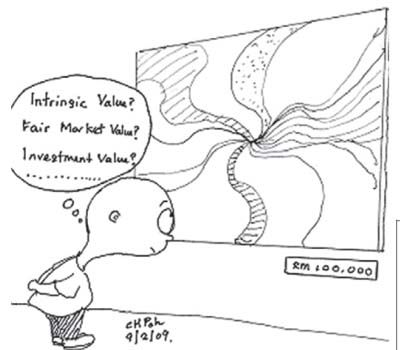 If you recently ordered my book Value.able, thank you and welcome! You have joined a small band of people for whom the inexplicable gyrations of the market will soon be navigated with confidence and far more understanding. If you have ever had an itch or the thought; “there must be a better way”, Value.able is your calamine lotion.
If you recently ordered my book Value.able, thank you and welcome! You have joined a small band of people for whom the inexplicable gyrations of the market will soon be navigated with confidence and far more understanding. If you have ever had an itch or the thought; “there must be a better way”, Value.able is your calamine lotion.Its hard to imagine that my declaration to Greg Hoy on the 7.30 Report that Myer was expensive as it listed at $4.10, or elsewhere that JB Hi-Fi was cheap and Telstra expensive has anything to do with the 17th century probability work of Pascal & Fermet.
The geneology of both modern finance and separately, the rejection of it, runs that far back. From Fermet to Fourier’s equations for heat distribution, to Bachelier’s adoption of that equation to the probability of bond prices, to Fama, Markowitz and Sharpe and separately, Graham, Walter, Miller & Modigliani, Munger and Buffett – the geneology of value investing is fascinating but largely invisible to investors today.
It seems the intrinsic values of individual stocks are also invisible to many investors. And yet they are so important.
My 24 June Post ‘Which 15 companies receive my A1 status?’ spurred several investors to ask what the intrinsic values for those 15 companies were. You also asked if I could put them up here on my blog so you can compare them to the valuations you come up with after reading Value.able. Apologies for the delay, but with the market down 15 per cent since its recent high, I thought now is an opportune time to share with you a bunch of estimated valuations.
I have selected a handful from the 15 ‘A1’ companies named in my 20 June post and listed them in the table below. The list includes CSL Limited (CSL), Worley Parsons (WOR), Cochler (COH), Energy Resources (ERA), JB Hi-Fi (JBH), REA Group (REA) and Carsales.com.au (CRZ).
If you are surprised by any of them I am interested to know, so be sure to Leave a Comment. And when you receive your copy of my book (I spoke with the printer yesterday who informed me the book is on schedule and will be delivered to you very soon), you can use it to do the calculations yourself. I am looking forward to seeing your results.
The caveats are of course 1) that the list is for educational purposes only and does not represent a recommendation (seek and take personal professional advice before conducting any transactions); 2) the valuations could change adversely in the coming days or weeks (and I am not under any obligation to update them); 3) these valuations are based on analysts consensus estimates of future earnings, which of course may be optimistic (or pessimistic, and will also change). They may also be different to my own estimates of earnings for these companies; 4) the share prices could double, halve or fall 90 per cent and I simply have no way of being able to predict that nor the news a company could announce that may cause it and 5) some country could default causing the stock market to fall substantially and I have no way of being able to predict that either.
With those warnings in mind and the insistence that you must seek advice regarding the appropriateness of any investment, here’s the list of estimated valuations for a selection of companies from the 15 A1 companies I listed back on 20 June.
Posted by Roger Montgomery, 6 July 2010
by Roger Montgomery Posted in Companies, Investing Education.
- 58 Comments
- save this article
- 58
- POSTED IN Companies, Investing Education.
-
Roger Montgomery co-interviews Oroton CEO Sally MacDonald with Peter Switzer
Roger Montgomery
June 4, 2010
Peter Switzer interviewed Sally MacDonald, CEO of Oroton Group last month on the Sky Business Channel. He invited Roger Montgomery to join them. Watch the interview.
by Roger Montgomery Posted in Media Room, TV Appearances.
- save this article
- POSTED IN Media Room, TV Appearances.
-
Is Value.able ever going to be available?
Roger Montgomery
May 4, 2010
 I have discovered through the book publishing process that being a perfectionist is costly. I have also discovered that being reasonably adept at investing does not make one even remotely adept at being the foreman of a book publishing project.
I have discovered through the book publishing process that being a perfectionist is costly. I have also discovered that being reasonably adept at investing does not make one even remotely adept at being the foreman of a book publishing project.I pulled the book out of the jaws of the printer when a few typos were spotted. Correcting the text of course threw the alignment out so it was back to the typesetters. The typesetters are an impressive group of designers and proofreaders and from them I learned that hyphenated sentences aren’t acceptable, and the top of a page can’t begin with the last word of the last sentence from the previous page. Who would have known?
The changes impacted the index so the book couldn’t go to the indexer until every word was in its final resting place. I didn’t even know there were “indexers”, let alone final resting places and even ‘widows and orphans’. Investing it seems is not the sole domain of jargon and lingo.
Happily my work is done and Value.able will be with the printer next week.
Patience is the hallmark of the world’s best investors. It appears patience is also the hallmark of every investor who has visited my blog or written me an email. Thank you.
Good things come to those who wait, and provided you have pre-registered with me you will soon receive an email announcing the opening of the ordering window and inviting you to claim your reserved copy of Value.able for $49.95, including GST and shipping anywhere in Australia.
If you are ordering from overseas, that’s no problem; country-specific delivery rates will be available. Finally, for those who have reserved multiple copies, as gifts for family and friends, don’t worry, your additional copies have been registered along with your copy.
I am only printing First Editions for those who have pre-registered at www.rogermontgomery.com so be sure to register. I look forward to your thoughts after you have read Value.able.
Posted by Roger Montgomery, 4 May 2010
by Roger Montgomery Posted in Insightful Insights, Investing Education.
-
Does Australia have too many levels of government?
Roger Montgomery
April 22, 2010
Roger Montgomery believes Australia has too many levels of government and discusses the impact on the health care sector. In this appearance on Your Money Your Call Roger also explains why Nufarm has been a B-class business for the past ten years and reveals his intrinsic valuations for First Australian Resources (FAR) and FKP Property Group (FKP). Watch the interview.
by Roger Montgomery Posted in Media Room, TV Appearances.
- save this article
- POSTED IN Media Room, TV Appearances.
